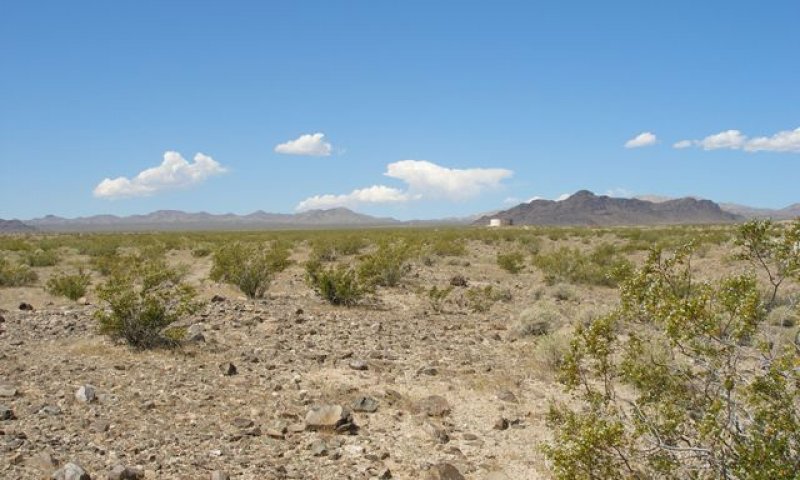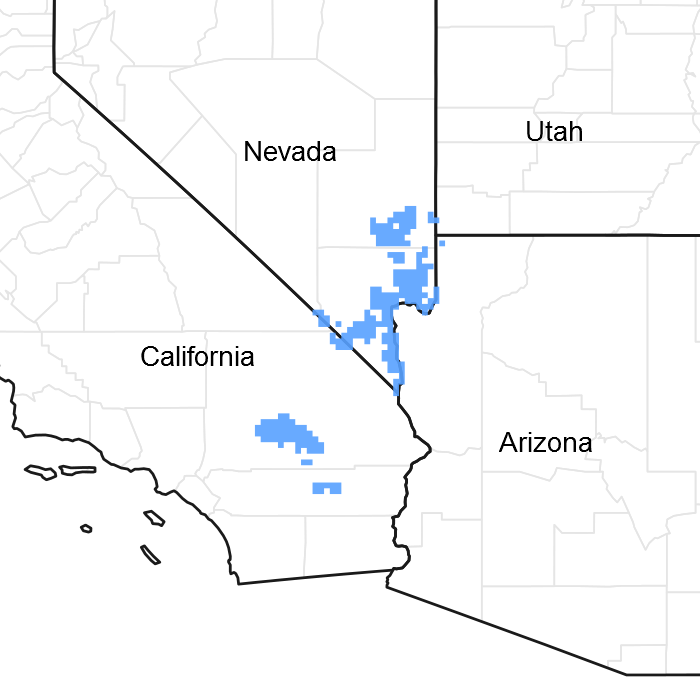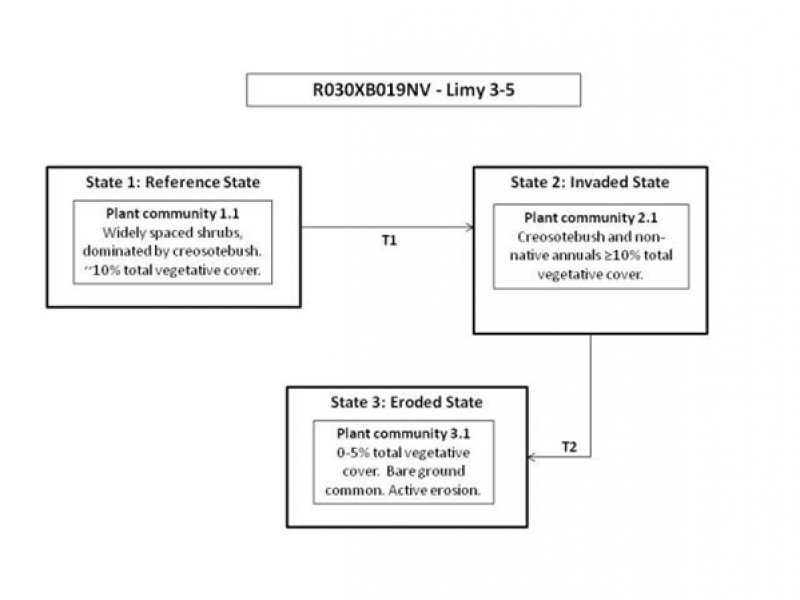Ecological dynamics
This creosotebush site is extensive throughout the Mojave Desert and consists of both long and short-lived perennial species. Creosotebush is a native, drought tolerant, evergreen perennial. In stable, old communities, individual creosotebush or clones may attain ages of several thousand years. Creosotebush persists throughout the successional process, but dominates in late successional communities due to its low recruitment and mortality rates.
Defoliation and branch death of creosotebush may occur as a result of long periods of intense moisture stress. Flowering and seed development is directly related to moisture availability, flowering generally occurs in the spring but can occur at any time during the summer if it receives enough rain (Marshall 1995). Creosotebush can produce essential resources (root exudates, leaves, sap, nectar, pollen and seeds) during almost every year of its long life. Germination is related to rainfall and recruitment events are infrequent. The root system of creosotebush consists of a shallow tap root and an extensive system of lateral roots. Sinker roots that originate from lateral roots can penetrate through breaks in cemented soil horizons to extract water during drought in order to maintain physiologically viable tissue water potentials. Consequently, the species is ecologically reliable and supports the lives of many desert animals (Pavlik 2008).
In this system, the clast cover is the dominant control of water and sediment distribution (Wood et al. 2005). Depth of soil water movement is strongly tied to surface clast distribution. Due to the high percentage of surface clasts and fine grained materials of the vesicular horizon, desert pavement sites experience minimal infiltration. Runoff is increased by this process, leading to maximum infiltration and deeper leaching when surface water reaches islands of vegetation on the landscape (Graham et al. 2008). Soils under desert pavements also have high concentrations of nitrate near the surface (Graham et al. 2008). These accumulations are largely a function of desert pavement hydrology. Since infiltration is severely impeded, soils underneath desert pavements experience minimum leaching and salts in the upper soil profile remain there. Nitrate is highly soluble, therefore it is quickly used by plants and excess nitrate is promptly leached away in moist soils. Researchers assume the high salinity and lack of available moisture beneath desert pavement prevent plant roots from accessing the nitrate stored there (Graham et al. 2008).
The frost-free season can last for the better part of a year. However, vegetation is limited by nutrient availability. Nutrient availability in the Mojave Desert is characterized by resource pulses. High temperatures and relatively small rainfall events allow nutrients to accumulate during extended dry periods when plant and microbial growth is restricted. When rainfall events do occur, they trigger biological activities including plant growth and nutrient uptake (Collins et al. 2008). Resource pulse availability is strongly correlated to the presence of microbiotic crusts in arid systems. Microbiotic crusts fix both carbon and nitrogen, and can be considered functional resource reserves. These reserves have lower activation thresholds in relation to water availability than plants, creating nonlinear ecosystem interactions (Collins et al. 2008). This relationship facilitates plant growth in arid environments and allows plants to utilize nutrients that would otherwise remain unavailable during small precipitation events. Nutrient availability in arid systems is also influenced by “resource islands”, also called “islands of fertility”. Resource islands refer to the ability of plants, particularly long-lived perennial shrubs, to increase organic matter and nutrient cycling beneath their canopy. In addition to altering the edaphic environment, these islands provide important habitat for animals, birds, reptiles, and insects (Bainbridge 2007).
Surface disturbance may reduce plant cover, density and diversity and increase erosion on this site. These changes can be very subtle or extremely obvious depending on the intensity and rate of use and an assortment of environmental factors (topography, rainfall, soil type). Desert pavement formed as a function of eolian erosion and deposition, therefore the site is not vulnerable to wind erosion if surface clasts are intact. If disturbed, the fine grained materials of the vesicular horizon will be released into the air potentially causing ecological and health problems (Yonovitz and Drohan 2009). Anthropogenic disturbances disrupt the pavement surface and increase erosion. However, studies have shown that soil functions related to pore morphology are not significantly affected by disturbance. Characteristics of the vesicular horizon, including the non-connected nature of the pores and its effect on restricting infiltration are able to rapidly recover to pre-disturbance conditions (Yonovitz and Drohan 2009). The implications of this are that the increased availability of nitrogen will not facilitate increased vegetative growth because infiltration will continue to be impeded even following disturbance. Creosotebush, after physical damage, has the ability to resprout from axillary buds hidden in the bark of the woody stems (Gibson et al. 2003). Destructive impacts such as land clearing can reduce long-lived creosotebush. The opportunistic perennials such as rayless goldenhead (ACSP), white burrobush (HYSA), and wire lettuce (STEPH) will increase. With a loss of perennial cover, non-native annual grasses and forbs such as red brome (BRRU2), Mediterranean grass (SCBA), and redstem filaree (ERCI6) will readily invade this site.
Fire Ecology:
Prior to Euro-American settlement, fire regimes in Mojave Desert shrub communities were characterized by relatively infrequent, stand-replacing fires with return intervals in the range of 35 years to several centuries. Mojave Desert communities are typically unaffected by fire because of low fuel loads, although a year of exceptionally heavy winter rains can generate fuels by producing a heavy stand of annual forbs and grasses. Plant species, native to the Mojave Desert, produce very little biomass, and communities generally have large interspaces, characteristics which are not conducive for carrying fire across the landscape. When fires do occur, the effect on the ecosystem may be extreme due to the harsh environment and the slow rate of recovery.
An altered fire regime can be detrimental to native plants that are not adapted to a frequent fire return interval. Fire can increase resource availability by reducing the amount of resources (moisture, nutrients) used by resident vegetation through mortality or injury (Zouhar et al. 2008). This increased resource availability can make the ecosystem more susceptible to invasions by non-natives. Relative competitive ability post-fire controls the invasibility of a system. Often non-natives have superior competitive ability for resources such as water, nutrients and light. Creosotebush foliage is resinous and very flammable, and even low severity fires result in high mortality (Marshall 1995). White bursage and creosotebush possess limited sprouting ability, thus can be killed by fire. White bursage, however, can rapidly re-establish from off-site seed. Range ratany generally reproduces sexually from seed, but has also been known to sprout post-fire (Griffith 1991). Damage to big galleta from fire varies. If big galleta is dry, damage may be severe. However, when plants are green, fire will tend to be less severe and damage may be minimal, with big galleta recovering quickly.
State 1
Reference State
This state is representative of the natural range of variability prior to Euro-American settlement conditions. Plant community phase changes are primarily driven by long-term drought. Insect attack and wildfire are infrequent, but have long-term impacts on the plant community. The reference state is depicted by one general community phase. This community is characterized by dynamic stability. It is stable and long-lived, but is dynamic in response to changes in disturbance regimes and weather patterns.
Community 1.1
Reference Plant Community

Figure 4. reference plant community
The reference community phase is dominated by creosotebush. Other species include white bursage, range ratany and big galleta. Perennial grasses and forbs are sparse. In wet years, annual forbs are common, especially desert Indianwheat (PLOV). Potential vegetative composition is 90 percent shrubs with approximately 5 percent grasses, 5 percent annual and perennial forbs. Approximate ground cover (basal and crown) is less than 10 percent. Although the total vegetative cover is quite low, bare ground is not abundant. Desert pavement is common and important for soil stability. Desert pavement is characterized by dynamic stability, small scale disturbances can self-repair by natural processes (Haff and Werner 1996). Prolonged drought will result in an overall reduction in the plant community.
Table 5. Annual production by plant type
| Plant type |
Low
(lb/acre) |
Representative value
(lb/acre) |
High
(lb/acre) |
| Shrub/Vine |
67 |
113 |
180 |
| Forb |
4 |
6 |
10 |
| Grass/Grasslike |
4 |
6 |
10 |
| Total |
75 |
125 |
200 |
| Jan |
Feb |
Mar |
Apr |
May |
Jun |
Jul |
Aug |
Sep |
Oct |
Nov |
Dec |
| J |
F |
M |
A |
M |
J |
J |
A |
S |
O |
N |
D |
State 2
Invaded State
The invaded state is characterized by the presence of non-native species. Compositionally, State 2 is similar to the reference state with a trace of non-natives in the understory. The presence of non-native annuals such as red brome, Mediterranean grass, and red-stem filaree reduce ecological resistance and resilience, making it more difficult for this state to recover following a disturbance. Non-natives annuals are highly flammable and promote wildfires where fires historically have been infrequent. Creosotebush persists through invasion by non-native annuals, but the other shrubs and desirable grasses suffer from increased competition and may be removed from the system.
Community 2.1
Plant Community Phase 2.1
This community phase is compositionally similar to the reference community phase with the presence of non-native species in the understory. Ecological processes such as; nutrient cycling, energy capture and soil hydrology are not compromised at this time. However, non-natives are favored and will increase if disturbance frequency varies from the historic range of variation. Total vegetative cover will increase slightly due to the presence of non-native annuals. This plant community is identified as “at risk”. Surface disturbances contributing to the introduction of non-natives may also damage desert pavement, increasing bare ground and decreasing ecological resistance and resilience, leaving the site susceptible to increased erosion. Non-natives provide a continuous bed of fine fuels increasing susceptibility to wildfire. Prolonged drought will result in an overall reduction in the plant community, including non-natives.
State 3
Eroded State
The Eroded State is characterized by reduced vegetative cover, loss of desert pavement and increased bare ground. Persistent and severe surface disturbance, reduced soil moisture and active soil loss prevents establishment and recovery of long-lived native perennials and desert pavement through natural processes. Non-native annuals are of tolerant degraded conditions.
Community 3.1
Plant Community Phase 3.1
This community phase is characterized by low vegetative cover and reduced surface gravels. Non-natives are present in the plant community. Severe reduction or loss of deep-rooted native perennials reduces organic matter inputs and infiltration rates. These changes affect water availably, resistance to erosion and plant production. Damage to desert pavement releases fine-grained materials of the vesicular horizon, causing soil loss. Rain, wind, and surface water all contribute to increased erosion. Prolonged drought will lead to further reduction of the plant community, increasing susceptibility to erosion.
Transition 1
State 1 to 2
Trigger: Introduction of non-native species.
Slow variables: Surface disturbance, changes in the kinds of animals and their grazing patterns, drought and/or changes in fire history that altered the recruitment rate of native species.
Threshold: Non-native species cannot be easily removed from the system and have the potential to significantly alter disturbance regimes from their historic range of variation. Changes in the herbaceous understory, associated with the introduction of non-native annuals, and decreased cover of desert pavement, reduce ecological resistance and resilience following a disturbance.
Transition 2
State 2 to 3
Trigger: Catastrophic event (ex: wildfire, land clearing, drought, heavy rain event) that removes or kills existing perennial vegetation.
Slow variables: Persistent surface disturbances such as; off-highway vehicle use, military operations, changes in the kinds or grazing animals and their grazing patterns, or settlements that damage desert pavement, remove existing perennial vegetation and alter recruitment rates of native species.
Threshold: Severe reduction or loss of deep-rooted native perennials leads to changes in energy flow, soil hydrology and nutrient cycling. Decreased infiltration and increased runoff reduces soil stability contributing to erosion and soil loss.




